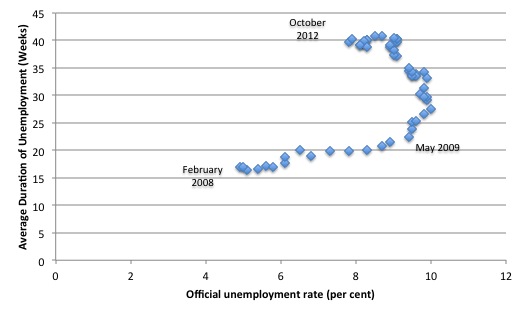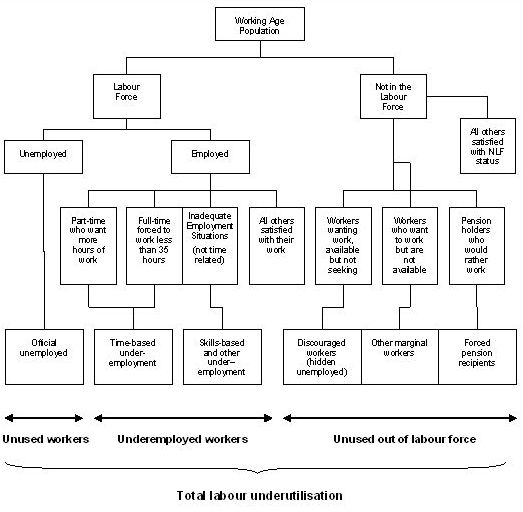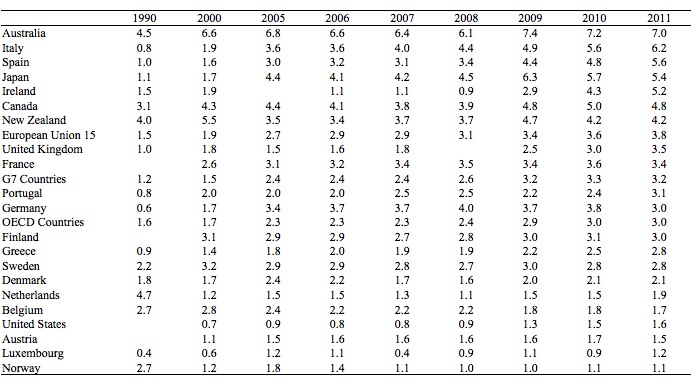It’s Wednesday and I just finished a ‘Conversation’ with the Economics Society of Australia, where I talked about Modern Monetary Theory (MMT) and its application to current policy issues. Some of the questions were excellent and challenging to answer, which is the best way. You can view an edited version of the discussion below and…
Labour market measurement – Part 3
I am now using Friday’s blog space to provide draft versions of the Modern Monetary Theory textbook that I am writing with my colleague and friend Randy Wray. We expect to complete the text by the end of this year. Comments are always welcome. Remember this is a textbook aimed at undergraduate students and so the writing will be different from my usual blog free-for-all. Note also that the text I post is just the work I am doing by way of the first draft so the material posted will not represent the complete text. Further it will change once the two of us have edited it.
Chapter 10 The Labour Market
Sections 10.1 and 10.2 were sketched in this blog – The labour market is not like the market for bananas, while Section 10.3 was started in this blog – Labour market measurement – Part 1. Last week I added – Labour market measurement – Part 2.
[Today I move on to discuss problems with the unemployment rate as a measure of labour market performance]
[NEW TEXT FOR TODAY STARTS HERE]
10.6 Duration of Unemployment
The unemployment rate is considered to be a narrow measure of labour market performance. One aspect that it hides is the duration of unemployment. As the discussion of flows indicated, the labour market is a very dynamic part of the economy with large flows between the labour force states occurring on a weekly basis.
The magnitude of these flows is, however, highly cyclical and net flows into unemployment are larger during a recession than in other times. If unemployment was a relatively ephemeral state for any individual then we would not be as concerned as if that individual endured longer spells of unemployment.
It is therefore important to consider the average duration of unemployment as part of our assessment of the state of the labour market.
The Australian Bureau of Statistics – Labour Statistics: Concepts, Sources and Methods – provides the following definition:
Duration of unemployment is defined as the elapsed period to the end of the reference week since the time a currently unemployed person began looking for work, or since a person last worked for two weeks or more, whichever is the shorter. Brief periods of work (of less than two weeks) since the person began looking for work are disregarded.
This conceptualisation is representative across nations even if there are some country-by-country variations in how the Labour Force Survey is collected.
The duration of unemployment influences the way we assess the distributional impacts of a recession. If, for example, individuals who become unemployed only endure short spells of unemployment – that is, average duration in weeks is low – then the impact on their income flow and accumulated saving will be lower than if the spells of unemployment are longer. A drawn-out recession typically has the effect of wiping out any savings that the unemployed person may have accumulated.
For a given unemployment rate, an economy might be characterised by a predominance of short spells of unemployment (many people flowing in and out of the unemployment pool) or at the other extreme the same people enduring long spells of unemployment (low inflows and outflows to the unemployment pool).
While any unemployment above some irreducible minimum rate is problematic, clearly the situation where the durations of unemployment is longer is more costly. We discuss the concept of an irreducible minimum rate of unemployment in the section on full employment later in the Chapter.
As an example, assume an economy has a labour force of 100 person and is enduring an unemployment rate of 8 per cent. This might occur if 8 individuals had become unemployed at the beginning of the month but who will find work in the following month. Next month 8 different individuals become unemployed.
The same economy might have the same 8 individuals enduring unemployment month-after-month and still maintain an unemployment rate of 8 per cent.
The duration of unemployment displays distinct cyclical patterns. As economic activity starts to slow and enter recession, there are large flows into the unemployment pool and so short-term unemployment surges. So the overall pool of unemployment is more weighted to individuals with short duration spells of unemployment.
As the recession endures and the net inflows into unemployment remain positive but start to decrease, more workers move into longer duration categories of unemployment and long-term unemployment increases. The average duration of unemployment starts to rise more sharply at this stage. The longer the recession the higher will be the long-term unemployment rate.
This pattern endures even after the economy is recovering. As the flows into unemployment start to fall the pool of unemployment is now more heavily weighted by individuals with longer spells of unemployment. As a result, average duration of unemployment continues to increase even though the unemployment rate might start falling.
The problem is that in the early stages of the recovery, employment growth has to be strong enough to absorb the new entrants into the labour force (that is, keep pace with the underlying population growth) and start eating into the huge pool of unemployed. There is evidence, which we discuss later, that suggests in the early stages of the recovery, firms prefer to employ workers who have only endured short spells of unemployment. In other words, the longer a person has been unemployed the lower will be the probability of them gaining work.
Figure 10.5 plots data from the US Bureau of Labor Statistics to illustrate the way that average duration of unemployment behaves during a downturn and early stages of recovery.
In February 2008, the official US unemployment rate was 4.9 per cent and the average duration of unemployment was 16.9 weeks.
In the first 12 months of the downturn, the unemployment rate increased by 2.9 percentage points and the average duration of unemployment rose by 2.9 weeks.
However in the second-year of the downturn, the unemployment rate increased by 1.4 percentage points but the average duration of unemployment rose by 10.2 weeks. Even as the unemployment rate started to decrease in the third year of the crisis (by -0.7 percentage points), average duration of unemployment continued to increase by 7.3 weeks.
Figure 10.6 Unemployment rate and Average duration of unemployment (weeks), US, February 2008 to October 2012

Source: US Bureau of Labor Statistics
[NOTE THERE WILL BE A SHORT EMPIRICAL SECTION DETAILING THE DIFFERENT DURATIONS IN OECD NATIONS WITH A DISCUSSION]
10.7 Broad measures of labour underutilisation
[NOTE: In the actual text, Figure 10.1 will not be repeated. I am including it here to make it easier for blog readers to access the argument without going back to the earlier blog]
Figure 10.1 summarised the Labour Force Framework as applied in Australia which , is made operational through the International Labour Organization (ILO) and its International Conference of Labour Statisticians (ICLS). Thus all national statistical agencies have broadly similiar structures for collecting data about the labour market.
Figure 10.1 The Labour Force Framework

We focus on the unemployment as an indicator of labour market performance because it signifies a waste of productive resources, quite apart from the individual and social costs that accompany it. However, unemployment is a narrow measure of labour underutilisation.
Labour underutilisation arises from a number of different reasons that can be subdivided into two broad functional categories:
- A category involving unemployment or its near equivalent – In this group, we include the official unemployed under ILO criteria and those classified as being not in the labour force on search criteria (discouraged workers), availability criteria (other marginal workers), and more broad still, those who take disability and other pensions as an alternative to unemployment (forced pension recipients). These workers share the characteristic that they are jobless and desire work if there were available vacancies. They are however separated by the statistician on other grounds; and
- A category that involves sub-optimal employment relations – Workers in this category satisfy the ILO criteria for being classified as employed but suffer time-related underemployment or inadequate employment situations.
We will consider the near equivalent states of unemployment in the next section. For now we will focus on underemployment.
With the Labour Force framework, a person of working age is considered employed if they have worked a minimum number of hours in the reference week for pay. Otherwise, they are classified as unemployed or not in the labour force, depending on how they fit into the activity criteria. In Australia, for example, a person only has to work one hour a week to be classified as employment by the Australian Bureau of Statistics. Varying lengths apply in different countries.
Underemployment may be time-related, referring to employed workers who are constrained by the demand side of the labour market to work fewer hours than they desire, or to workers in inadequate employment situations, where skills are wasted, income opportunities denied and/or where workers are forced to work longer than they desire.
Clearly, if society invests resources in education, then the skills developed should be used appropriately. The concept of an inadequate employment situations are very difficult to quantify and there is a paucity of data available as a result to measure it. However, national statisticians have developed sophisticated measures of time-related underemployment.
In conceptual terms, a part of an underemployed worker is employed and a part is unemployed, even though they are wholly classified among the employed.
An economy with many part-time workers who desire but cannot find full-time work is less efficient than an economy with labour preferences for work hours satisfied. In this regard, involuntary part-time workers share characteristics with the unemployed.
Time-related underemployment is similar to unemployment because it arises from a deficiency in aggregate demand. In the case of the latter the demand-deficiency manifests as a lack of jobs on offer, whereas in the case of underemployment the demand constraint rations the hours of work that are offered by firms.
In both cases, willing labour resources are wasted.
The two concepts of underemployment are also related. The rising incidence of underemployment over the last 20 years in many countries has been associated with a rising casualisation of the workforce as government have tilted the industrial relations playing field towards employers and reduced workplace protections and restrictions on the use of non-standard hours of work.
As a result, the quality of employment has fallen for many workers. This trend has also coincided with the growth of the service sector and in many nations (such as the US, Australia, Britain) this growth has been concentrated in lower-skilled, less stable jobs. Underemployment is common in these sectors.
We will see in Section 10.7 that a meaningful definition of full employment has to include zero underemployment. A worker cannot be considered full employed if they are enduring underemployment.
Figure 10.7 show the evolution of underemployment in a selection of OECD nations since 1990, ranked highest to lowest as at 2011.
[DISCUSSION TO FOLLOW]
Figure 10.7 OECD Underemployment, per cent of labour force

[NOTE FURTHER TABLES SHOWING UE AS % OF PT EMPLOYMENT OVER SAME PERIOD AS FIGURE 10.7 AND UNEMPLOYMENT, UNDEREMPLOYMENT AND TOTAL OF TWO FOR OECD NATIONS AS AT 2011]
Hysteresis
One of the reasons we worry about situations where the duration of unemployment is high for extended periods relates to the concept of path-dependence or hysteresis.
One of the reasons for this relates to what we call unemployment hysterisis. Hysteresis is a term drawn from physics and is defined by the Oxford Dictionary as :
… the phenomenon in which the value of a physical property lags behind changes in the effect causing it, as for instance when magnetic induction lags behind the magnetizing force.
In economics, we sometimes say that where we are today is a reflection of where we have been. That is, the present is path-dependent. We will consider this effect in Chapter 11 Unemployment and Inflation because it has implications for how we conceptualise an unemployment rate that is consistent with stable inflation.
We will learn that the hysteresis effect describes the interaction between the actual and equilibrium unemployment rates. The significance of hysteresis is that the unemployment rate associated with stable prices, at any point in time should not be conceived of as a rigid non-inflationary constraint on expansionary macro policy. The equilibrium rate itself can be reduced by policies, which reduce the actual unemployment rate.
For the discussion in this Chapter we will confine ourselves to the way the economic cycle impacts on hiring in the labour market.
Recessions cause unemployment to rise and due to their prolonged nature the short-term joblessness becomes entrenched long-term unemployment. We would observe rising average duration of unemployment as the long-term unemployment rises.
However, the unemployment rate behaves asymmetrically with respect to the economic cycle which means that it jumps up quickly but takes a long time to fall again.
There is robust evidence pointing to the conclusion that a worker’s chance of finding a job diminishes with the length of their spell of unemployment. When there is a deficiency of aggregate demand, employers use a range of screening devices when they are hiring. These screening mechanisms effectively “shuffle” the unemployed queue.
Among other things, firms increase hiring standards (for example, demand higher qualifications than are necessary) and may engage in petty prejudice. A common screen is called statistical discrimination whereby the firms will conclude, for example, that because, on average, a particular demographic cohort has higher absentee rates (for example), every person from that group must therefore share those negative characteristics. Personal characteristics such as gender, age, race and other forms of discrimination are used to shuffle the disadvantaged workers from the top of the queue.
In this context, the concept of hysteresis relates to how the labour market adjust over the economic cycle. In a recession, many firms disappear all together, particularly those who were using very dated capital equipment that was less productive and hence subject to higher unit costs than the best practice technology.
The skills associated with using that equipment become obsolete as it is scrapped. This phenomenon is referred to as skill atrophy. Skill atrophy relates not only to the specific skills needed to operate a piece of equipment or participate in a firm-specific process.
Long-term unemployment also erodes more general skills as the psychological damage of unemployment impacts on a worker’s confidence and bearing. A lot of information about the labour market is gleaned informally via social networks and there is strong evidence pointing to the fact that as the duration of unemployment becomes longer the breadth and quality of an unemployed worker’s social network falls.
Further, as training opportunities are typically provided with entry-level jobs it follows that the (average) skill of the labour force declines as vacancies fall.
New entrants to the labour force – into the unemployment pool because of a lack of jobs – are denied relevant skills (and socialisation associated with stable work patterns).
As a result, both groups of workers – those made redundant and the new entrants – need to find jobs in order to update and/or acquire relevant skills. Skill (experience) upgrading also occurs through mobility, which is restricted during a downturn.
Therefore, workers enduring shorter spells of unemployment, other things equal, will tend to be more to the front of the queue. Firms form the view that those who are enduring long-term unemployed are likely to be less skilled than those who have just lost their jobs and with so many workers to choose from firms are relucatant to offer any training.
However, just as the downturn generate these skill losses, a growing economy will start to provide training opportunities as the unemployment queue diminishes. This is one of the reasons that economists believe it is important for the government to stimulate economic growth when a recession is looming to ensure that the skill transitions can occur more easily.
Conclusion
NEXT WEEK I WILL MOVE ONTO THEORETICAL DEBATES ABOUT UNEMPLOYMENT WHICH WILL LEAD INTO THE DISCUSSION ABOUT UNEMPLOYMENT AND INFLATION.
Saturday Quiz
The Saturday Quiz will be back again tomorrow. It will be of an appropriate order of difficulty (-:
That is enough for today!
(c) Copyright 2012 Bill Mitchell. All Rights Reserved.
“This is one of the reasons that economists believe it is important for the government to stimulate economic growth when a recession is looming”.
If this were wikipedia, I would slap a ‘citation needed’ tag on that statement. I don’t hear hear professional economists clamouring for government stimulus at the mere prospect of a recession. Quite a few didn’t seem too keen on the idea even in the midst of the recent GFC.
the table 10.1 comes from an earlier section, and i’m not sure where the comment that i would like to share fits within your chapters, however, it should be relevant for your book. There are some factors in the LF chart that are not mentioned., eg., the labour force schema presented could also include those over-employed, working too many hours, which is an indication of labour untilization and the lack of decency of work. of course i’m not wanting to make the case for time adjustment/sharing policies, however, the amount of labour (in terms of time) that workers are required to contribute, some times paid but often unpaid, probably deserves some visibility. there is also the exploitation angle – those that are exploiting themselves (over-employed for below poverty line wages – typically the self employed) and those that are being exploited (slaves).
there might also be others?